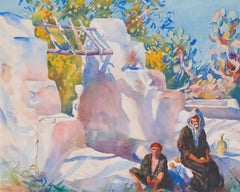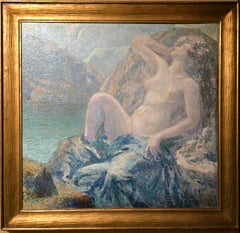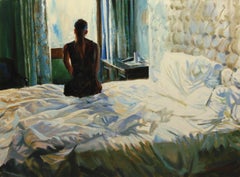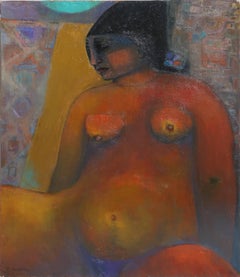Vermontology Figurative Paintings
to
1
1
Overall Width
to
Overall Height
to
2
1
1
1
1
2
2
1
1
1
1
2
1
1
1
1
2
2
By the Well, Aiden Ripley
By Aiden Lassell Ripley
Located in North Clarendon, VT
By the Well, a stunning watercolor by Aiden Lassell Ripley. Painted in 1925, 15.75" x 19.5", Vose Gallery label on verso. Signed and dated lower left.
Aiden Lassell Ripley (1896–1...
Category
1920s Abstract Impressionist Figurative Paintings
Materials
Watercolor
Hills in Norway - Sigurd Skou
By Sigurd Skou
Located in North Clarendon, VT
Hills in Norway by Norwegian American artist Sigurd Skou. Stunning oil on Canvas housed in a period arts and crafts carved frame.
Born in Fredrikshald,...
Category
1910s American Impressionist Figurative Paintings
Materials
Oil
Related Items
Morning Contemplation, Oil Painting
By Onelio Marrero
Located in San Francisco, CA
Artist Comments
"In this painting, I wanted to further my explorations of interiors in dramatic lighting and the look of folds on unmade beds," explains artist Onelio Marrero...
Category
21st Century and Contemporary Abstract Impressionist More Art
Materials
Oil
Seated Nude, Contemporary Oil Painting on Canvas by Miriam Bromberg
By Miriam Bromberg
Located in Long Island City, NY
Artist: Miriam Bromberg
Title: Nude
Year: circa 1970
Medium: Oil on Canvas, signed l.l.
Size: 30 in. x 24 in. (76.2 cm x 60.96 cm)
Category
1970s Abstract Impressionist Figurative Paintings
Materials
Oil, Canvas
$2,240 Sale Price
20% Off
H 30 in W 24 in D 1 in
Mid Century Portrait of the Artist
Located in Soquel, CA
Mid-century self-portrait by California artist Myrtle Cureton (American, 1909-2000). Signed "Myrtle Cureton" lower left. Artist's Santa Cruz Art League ...
Category
1950s American Impressionist Portrait Paintings
Materials
Masonite, Oil
Basking in the Sun - Mid Century Modern Multicolor Female Figurative
By Jon Blanchette
Located in Soquel, CA
Multi-colored figurative oil painting of a woman in bikini bathing in the California sun by listed California artist Jon Blanchette (American, 1908-1987). The colorful background is...
Category
1950s American Impressionist Figurative Paintings
Materials
Masonite, Oil
$1,170 Sale Price
35% Off
H 20 in W 24 in D 1 in
"42nd St. Library -NYC-" Impressionist Oil Painting in the Style of Guy Wiggins
By Cindy Shaoul
Located in New York, NY
As described in the Financial Times: "With shades of Pierre Bonnard’s Parisian street vistas and Edward Hopper’s New York shopfronts, American impressionist Cindy Shaoul’s oil painti...
Category
2010s American Impressionist Landscape Paintings
Materials
Oil, Board
$720 Sale Price
20% Off
H 17 in W 14 in D 1.25 in
"Blooming pink almond branch "( pink flowers in a vase oil painting on canvas)
Located in VÉNISSIEUX, FR
This floral artwork makes my of my new small collection called 🪻"Primavera"🪻 dedicated to a springtime.
For me spring means rebirth, life, energy, new possibilities. Springtime ma...
Category
2010s Abstract Impressionist Still-life Paintings
Materials
Canvas, Oil
$910 Sale Price
30% Off
H 25.6 in W 21.26 in D 0.6 in
Rota, Spanish Landscape -- Pobre Casa Cadiz
By John Sackas
Located in Soquel, CA
Wonderful Spanish landscape of a humble farm in Rota, Cadiz, Spain with horses, a cow with two herons, one of which is on cow's back by San Francisco artist John Sackas (American, 1910-2004), circa 1950s. Signed lower Left "Sackas" and verso Rota
Farm House Cadiz" "John Sackas" . Verso has location, attribution and full artist's biography. Presented in gilt-toned carved wood frame. Image size: 14"H x 18"W.
Born in New Jersey on May 22, 1910. John Sackas studied at the San Francisco Art Institute (1934), Chouinard Art School in Los Angeles, Corcoran Gallery of Art, and California School of Fine Arts, Jerry...
Category
1950s American Impressionist Landscape Paintings
Materials
Oil, Canvas, Illustration Board
$812 Sale Price
35% Off
H 18 in W 22 in D 7 in
Blooms V - colorful impressionistic painting on linen canvas with 3d roses
Located in Zofingen, AG
Acrylic on linen canvas, 50x50x2 cm / 19,7x19,7x0,8 in.
This painting features a serene composition of red and pink roses, capturing the essence of tranquility and self-contentment....
Category
2010s Abstract Impressionist Abstract Paintings
Materials
Canvas, Linen, Acrylic
$437
H 19.69 in W 19.69 in D 0.79 in
Mid Century Le Coq Gaulois, French Roosters
By Helen Enoch Gleiforst
Located in Soquel, CA
Charming painting of colorful Gallic "Le Coq Gaulois" roosters by listed California artist Helen Enoch Gleiforst (American,1903-1997), circa 1950.
Born in...
Category
1950s American Impressionist Figurative Paintings
Materials
Masonite, Oil
$1,852 Sale Price
35% Off
H 26 in W 32 in D 1.5 in
"Portrait of a Seated Nude Woman" American Impressionist Painting Oil on Panel
By Robert Philipp
Located in New York, NY
A rare and breath taking work, with masterful bursh work and sublime execution of light. We are drawn to the subtle beauty and elegant pose. The tasteful compostion lends an intimate scene into the artists studio where Philip has captured her effortlessly. This piece comes displayed in a wonderful frame and hanging wire on verso.
Art measures 24 x 20 inches
Frame measures 30 x 26 inches
Robert Philipp was born on February 2, 1895 in New York City. He was an American painter influenced by Impressionism and Post-Impressionism, and known for his nudes, still lifes, and portraits of attractive women and Hollywood stars. Moses Solomon Philipp showed early talent and grew up in a family atmosphere that fed and cultivated his creativity. At age of 15, he entered the Art Students League for four years and then continued his training at the National Academy of Design. His teachers at the League included George Bridgeman and Frank DuMond, and at the National Academy he studied with Douglas Volk...
Category
1940s American Impressionist Nude Paintings
Materials
Oil, Panel
$3,200 Sale Price
57% Off
H 30 in W 26 in D 2 in
"Patterns" portrait of a woman, in maximalist room, colorful eclectic design
By Kelly Carmody
Located in Sag Harbor, NY
Kelly Carmody (b. 1977, Massachusetts) Rooted in realism, Carmody’s compositions start very traditional in subject and composition; however, she further transforms her skilled hand b...
Category
21st Century and Contemporary American Impressionist Figurative Paintings
Materials
Paper, Oil
$2,895
H 15.5 in W 11.5 in
"Risen Moon" Frederick Judd Waugh, Coastal Landscape, Rocky Coast Marine Scene
By Frederick Judd Waugh
Located in New York, NY
Frederick Judd Waugh
Risen Moon
Signed lower right, Grand Central Art Galleries Inc. label on verso
Oil on board
25 x 30 inches
Mainly known as a marine painter. Waugh's sea paintings were enthusiastically received; for five consecutive years, he was awarded the Popular Prize at the Carnegie International Exhibition. Waugh was the son of a well-known Philadelphia portrait painter, Samuel Waugh...
Category
1920s American Impressionist Figurative Paintings
Materials
Oil, Canvas
$19,200 Sale Price
20% Off
H 25 in W 30 in



